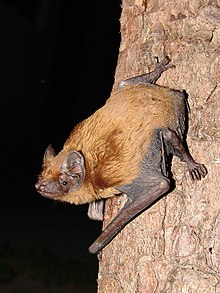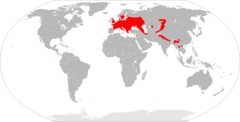Nyctalus noctula
| Common noctule | |
|---|---|
 |
|
| Scientific classification | |
| Kingdom: | Animalia |
| Phylum: | Chordata |
| Class: | Mammalia |
| Order: | Chiroptera |
| Family: | Vespertilionidae |
| Genus: | Nyctalus |
| Species: | N. noctula |
| Binomial name | |
|
Nyctalus noctula (Schreber, 1774) |
|
 |
|
| Range of N.noctula | |
The common noctule (Nyctalus noctula) is a species of bat common throughout Europe, Asia, and North Africa.
The UK distribution can be found on the National Biodiversity Network website here
With a length of 8 cm and a wingspan of 35 cm, the common noctule bat is one of the largest in western and central Europe.
In addition to the typical ultrasounds the noctule bat may expel shrill cries; this is a mating call.
Noctule bats hibernate in winter, and sometimes congregate in hibernation colonies of up to 1000 individuals. Tree holes are not warm enough so they search caves, objects like church steeples or blocks of flats in Eastern Europe, where they are most common hibernating bat species in the cities. Sometimes summer territories and hibernating places are hundreds of kilometres apart.
The noctule uses two main calls for echolocation. The frequencies of the first are 26–47 kHz, have most energy at 27 kHz and an average duration of 11.5ms. The frequency of the second call is 22–33 kHz, having most energy at 22 kHz and an average duration of 13.8ms.
Small to medium-sized woodlands are preferred but they may forage up to 20 km from the woodland at night. When roosting through the day, the noctule bat usually seeks out tree holes or even bat boxes attached to the tree trunks.
Generally noctule bats live in forests, but some populations can be found in towns. There are many noctules in Hamburg, Vienna, Brno and some other central European cities.
During the summer, male noctules are solitary or form small bachelor groups. In Europe, the species nursing area is mainly in the northern parts of the species’ distribution area. The southern boundary of the main part of the nursing area mainly follows 48°–49°N latitude. With the exception of the main breeding area, several smaller and isolated breeding areas are known – recorded in Slovakia, Hungary, Bulgaria, Slovenia Iberian Peninsula and Italy.
When hunting, it often starts flying in early dusk, earlier than most European bats. It flies high above the forested areas that are its preferred habitat, reaching speeds of up to 50 km/h.
...
Wikipedia

